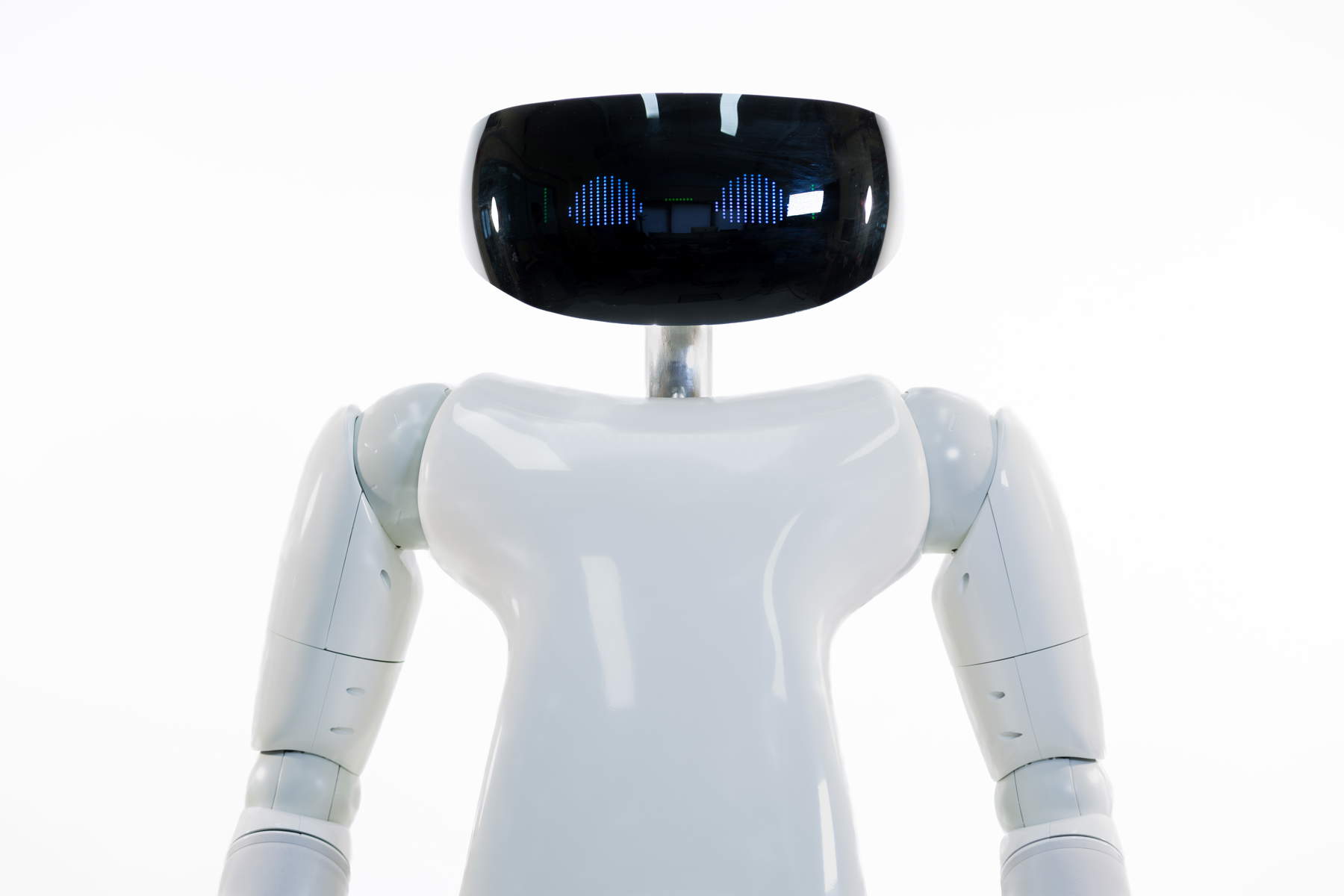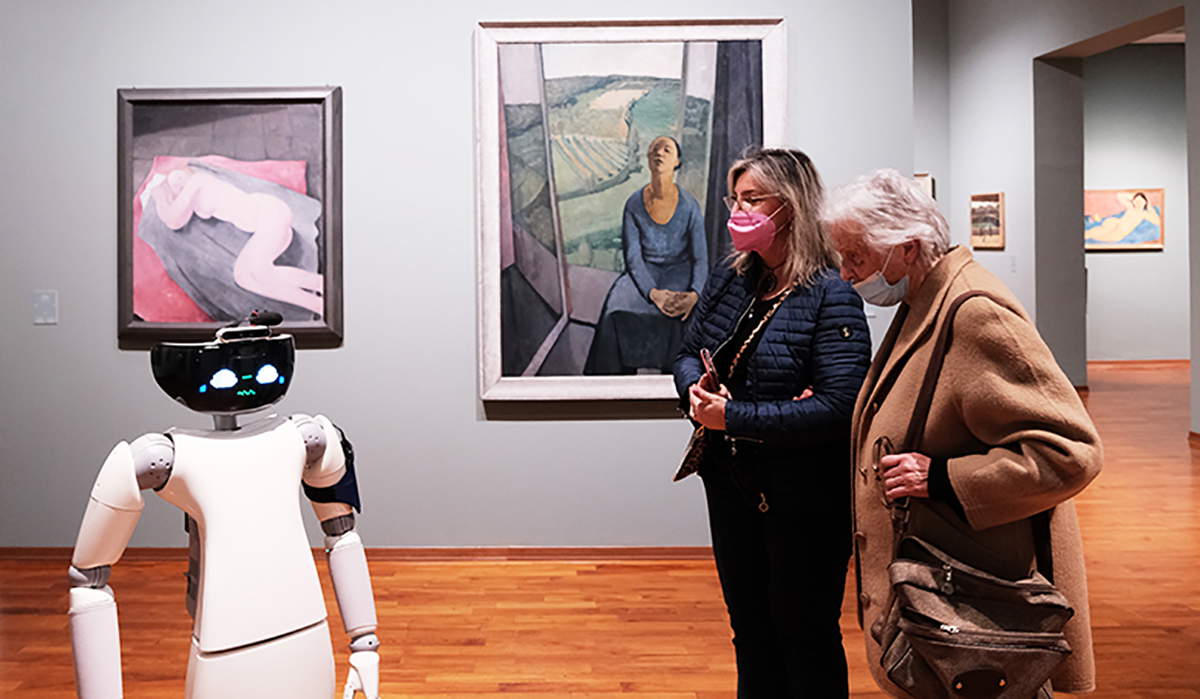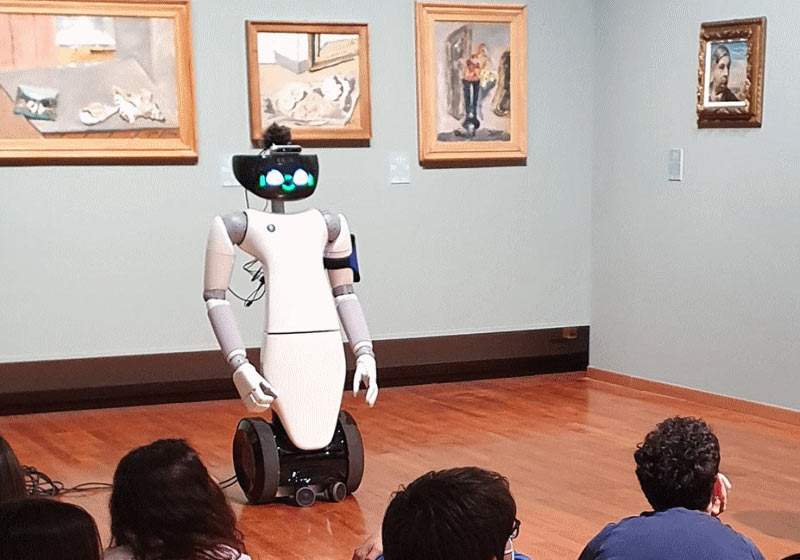News of the first trials involving the application of innovative digital technologies at the service of cultural experiences within Turin ’s museums thanks to the 5G network has not gone unnoticed. The tests, part of theEuropean Union-funded 5G-TOURS project “5G smarT mObility, media and e-health for toURists and citizenS,” City of Turin - Department and Innovation Directorate, in collaboration with theAssessorato alla Cultura - Ericsson, TIM, Fondazione Torino Musei and Istituto Italiano di Tecnologia di Genova, with the contribution of international partners Atos and Samsung, were held (and are still ongoing) in May in the halls of GAM and Palazzo Madama.
Specifically, from May 9 to 13, Palazzo Madama gave its visitors the opportunity to enjoy three different experiences: a telepresence guided tour of the Palazzo’s basement, which is not normally open to the public, thanks to the Double 3 Minirobot that, exploiting 5G technology, is able to move with responsiveness and precision even in the tightest spaces; an educational that through Meta Quest viewers, also connected to the 5G network, allows the public to solve a puzzle by repositioning the paintings of Camera delle Guardie in their frames, virtually handling and moving the works in the room that, in reality, it is not possible to touch; and, finally, the guided tour in the Ceramics Room on the second floor accompanied by R1, a humanoid robot designed by theItalian Institute of Technology in Genoa and conceived to operate in home and professional environments, whose autonomous and remote navigation system integrates well with the bandwidth and latency offered by a 5G connection. During the experiment days, I had the opportunity to participate in one such visit, the one with the humanoid robot R1: here’s how it went.

The R1 robot is 1 meter and 25 centimeters tall, weighs 50 kilograms and is composed of 50 percent plastic and the remaining 50 percent carbon fiber and metal. According to the museum’s website, R1 “is able to describe the works and answer questions about the author or the historical period to which they belong. 5G connectivity is needed to transmit to external computers the substantial amount of data generated by the sensors and algorithms that manage the robot’s perception of the environment, autonomous navigation and dialogue management, with very fast response times.”
The main microphone, located over the robot’s left shoulder, allows it to select before the visit the language it will speak in. There are also other microphones, placed in other areas of the humanoid’s body, but these are prototypes for the time being. Although it is equipped with eyes, these do not perform any function, but are actually only drawn on the screen that makes up the robot’s head, in order to make the machine’s features more aesthetically humanized (there is a special department that deals precisely withhuman-machine interaction).
Moving R1, which moves on wheels, are multiple infrared cameras that create a 3-D reconstruction of space. This is compared by the robot with a map of the environment that was provided to it earlier, allowing it to detect any obstacles such as, for example, the wooden edging of the cases that store the ceramics. On the lower part of the body, a beam-like laser on a plane serves to measure additional obstacles and let it know where it is. Another laser, placed above his head, allows him to detect encumbrances that do not rest on the ground, such as wall display cases. The material with which it is clad on the outside is specially designed to enable the robot to feel pressure and allow it to react, should it encounter obstructions of which it was not previously made aware.
Before each visit, R1 needs to be recharged. He needs about 10 to 15 minutes to fully perform his functions. If it were not for the fact that a machine is conducting the activity, as far as the setting of the visit is concerned (predetermined route, speech to be given, language to be used) there would not be much difference with a traditional guided tour conducted through the classic audio guides that are rented at the museum entrance.
The notions that the robot conveys, thanks to a rather feminine-sounding voice system, as well as the route to be taken have been provided to it in advance, in the same way as the map of the space in which it moves. If there are too many noises in the environment, however, it tends to get confused and repeat what has just been said. In the event that it cannot recognize the space in which it is moving or if it finds unexpected obstacles such as, for example, people, it recalculates the path to the cry of “Make room for me.” Any interruption to the natural (or artificial?) course of events, whether physical or auditory obstacles, is recognized by the robot as a kind of system error. At the end of the visit, R1 invites participants to ask him questions and, if no one comes forward, to consult a specially created list of questions. Alternatively, one can choose to give the voice command “End tour.”



My approach to experiences of this kind, perhaps the result of an initial skepticism, is a mixture of curiosity and suspicion. There is no doubt that the scientific, innovative and digital research behind the project is of great value and is the result of the excellent work of expert minds. What I wonder, however, is: did we really need it? Wouldn’t it, instead, be more useful to apply the same kind of technology in contexts where the “machine” can generate real benefit for humans?
This is probably simplistic thinking on my part, relegating the use of technology to a mere subjugated tool in the service of people. And, likely, the same kind of skepticism has accompanied the various phases that have characterized technological evolution over time, in different fields. But in a context such as museums, where digital has long (though, perhaps, insufficiently widely) found use, the presence of a humanoid robot conducting guided tours adds nothing more to the experience undertaken, quite the contrary. What is narrated by R1 during the tour could be said by any museum guide, trained and experienced in doing their job. Clearly, human memory is fallacious, and the database of information with which any of us may be endowed is surely inferior to the data-storage capacity of a robot, with the understanding that even here a limitation exists. There is, in fact, an empathic and character component that is inevitably lacking in such an experience. Guided tours conducted by a live person consist not only of notions, but also of looks, gestures, smiles, intentions, intuitable even under masks. In short, the whole is far more than the sum of its individual parts.
The real advantage in using a humanoid to replace humans remains economic. The production costs, beyond initial experiments, of a robot like R1 depend primarily on the type of materials that make it up. The moment inexpensive, high-performance materials could be found, the machine could be mass-produced and, at that point, take over from humans. In the microcosm of the world of culture in which thousands of young graduates struggle to find a place, this scenario could take on the connotations of defeat. Museum guides are, unfortunately, among the victims of a sick system that characterizes the cultural labor market in Italy, with precarious contracts and inadequate salaries.
Returning to my experience of a guided tour with the humanoid robot R1, I wonder if it would not be perhaps the case to take a step back and review the elements that make up the equation: on the one hand the great potential of technical-scientific evolution, and on the other hand the pivotal points that characterize the activity of museums, namely the preservation and enhancement of heritage. A truly innovative solution should never forget this.
Warning: the translation into English of the original Italian article was created using automatic tools. We undertake to review all articles, but we do not guarantee the total absence of inaccuracies in the translation due to the program. You can find the original by clicking on the ITA button. If you find any mistake,please contact us.